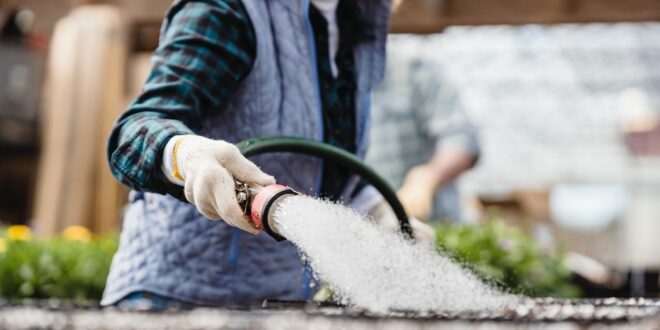When water restrictions hit, it can be heart-breaking to watch our gardens thirst, and the ground crack – yet it doesn’t have to be that way, even in the driest regions. Test drive these 8 ways to save water in the garden, and protect your precious plants from drought!
- Thirsty gardens often develop a hard crust. When you water them, most of the moisture runs off the hard surface and away form the very plant you’re targeting. Keep the surface of any exposed soil lightly tilled to create a great er, and more porous, surface area for catching water.
- When planting seedlings, create a small depression in the ground around them. This will allow moisture to pool and sit. The longer the moisture remains in the depression, the longer it is feeding water to the plant. The same method can be used for a whole row of seeds or seedlings, by creating a furrow.
- If you have the choice, always opt for watering plants in the morning, as early as possible. This gives the plants time to absorb the water before the sun evaporates the moisture. If water restrictions mean your only opportunity is to water at night, water around the base of plants, not on their leaves. Without the sun to dry the moisture from the foliage, leaves stay wet, often until morning, something which can cause fungal disease to move in or spread.
- In hot, dry weather, it’s better to water deeply (to the depth of half a spade-blade) every 2-3 days than to give plants just a little moisture every day. This allows water to reach the root zone of deep rooted plants, while encouraging shallow-rooted plants (such as tomatoes) to reach down into the desirable, cooler soil, for moisture
- If you’re targeting just one plant at a time with the garden hose, a good way to direct water straight onto roots is to snip off the base of a soda bottle and bury the bottle, screw-top end first, well into the soil beside the plant. (This is best done at the time of planting so roots aren’t disturbed at a later date.) Direct water into the open end of the bottle so it trickles straight down to the root zone.
- Mulching the garden with pea straw, weed-free compost, or pine needles, covers the soil’s surface, and reduces evaporation. But mulch can be expensive and difficult to obtain. A better option can be to plant your seedlings in such a way that, as they grow, they reach out to touch their neighbours with their leaves, thus shading the soil from the heat of the sun. This technique is simply achieved with salad greens, such as lettuces, when they’re planted a hand’s distance apart, and in a hexagonal pattern.
- If you enjoy growing plants in containers, and unglazed terracotta is your choice of planter, take care! Terracotta is a porous material, and moisture from the growing mix soon wicks its way to the outer surface of the pot from where it is quickly evaporated. Prevent this happening by lining your pot with black plastic. Cut it to just below the rim of the pot so its does not show when the container is filler. And don’t forget to make a drainage hole through your liner.
- Weed often in hot weather. Weeds are also plants, and will compete with your flowers and vegetables for any available water there is. Pull them up as soon as you see them, and if the weather is scorching, leave them lying on the surface of the garden as a mulch. Nothing is more satisfying that watching weeds wilt as they protect your plantings!
With careful management, your garden can stay moist much longer than you think possible!










Join the Discussion
Type out your comment here:
You must be logged in to post a comment.